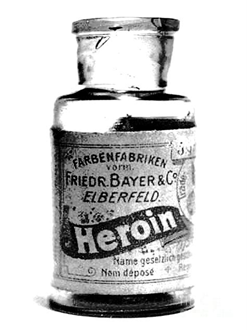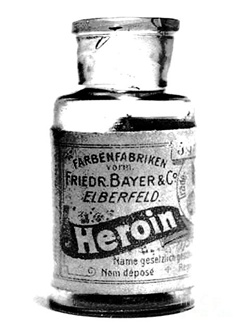Hon, please pick up some Bayer Heroin on your way home.
The search for effective pain medications was urgent in the late 1880s. We still had many Civil War veterans who has suffered horrible wounds and amputations. Many of them had been given morphine for their pain and now found themselves addicted to the drug.
Cities had been growing and the air was polluted with dust, coal dust, and fumes. Asthma, bronchitis, pneumonia, and tuberculosis were common, and they triggered incessant coughing. People were sick and could not even sleep well to get rest. But hope was on the horizon over in Germany.
Felix Hoffman, a research chemist at the Bayer Company, synthesized heroin in 1897. And the test subjects, employees at Bayer, said it made them feel heroic. Hence the brand name, Heroin. And, in addition to reducing pain, it worked as a respiratory depressant and reduced the constant coughing.

In 1898 Bayer had two wonder drugs on their hands: aspirin and heroin. Heinrich Dreser, Hoffman’s supervisor, was concern about the potential for aspirin to weaken the heart muscles, so he pushed for the production of heroin, especially mixed with cough syrup. It was marketed as having almost no toxic side effects and that it was non-addictive.
By 1899 Bayer was producing about a ton of heroin annually and marketed it to 23 countries. However, in 1902 researchers started to see the addictive nature of this wonder drug and by 1914 a doctor’s prescription was needed. Ten years later it was banned in the United States.
Lesson
Solutions often create new problems. It was true of the synthesizing of heroin to deal with pain, the after-work cocktail to help with stress, the overuse of antibiotics, and the morphing of social media. Nice solution — new problem.
Application
Think of a solution you’ve found for one of your nasty problems. Might there be a long-term unintended consequence?

